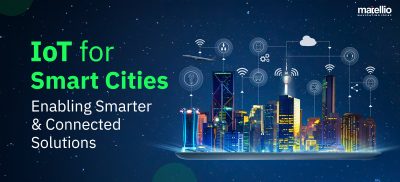
IoT in construction mix has proven to revolutionize. While helping construction workers ensure safety while working, IoT has greatly helped managers and real estate businesses to make informed strategic decisions about the material, assets, and more. Innovators are constantly developing ways to improve IoT implementation for their companies to deliver the right customer value and grow their revenue. This is exactly where IoT development services come in.
IoT development companies aim to drive full value from your investment by helping you create the right IoT infrastructure to propel your efforts in the right direction. Let’s see how they do that while looking at IoT implementation for the construction industry.
Many times, construction sites face the problem of low inventory. This increases the workforce’s idle hours and the construction time, which can be cost-inefficient. Having RFID tags associated with these assets helps you stay on top of the inventory status. These systems detect the decrease in inventory and send alerts anytime it is lower than the threshold value. Some IoT systems can also trigger repurchase events, and the inventory is restocked promptly. It also helps you channel your investments properly as you only need to have a specific amount of raw material on the site without suffering from insufficiency. IoT makes it easier for construction businesses to track and maintain their assets. With RFID tags installed with each asset, managers can properly locate the misplaced or lost assets. Having a clear idea about the assets also helps reduce the money invested in replacing them. This also reduces the chances of thefts and closely tracks the landscaping fleet. IoT-based sensors also help builders know about asset performance and plan the maintenance according to the schedule. They also help detect broken components and failures/ damages within the assets. Having prior knowledge about this enables users to plan the maintenance before any big issues occur. Also Read: How to Develop an IoT-based Asset Monitoring Solution for Your Business? The construction industry is labor intensive and includes a highly risky work environment. According to the US department of labor, there are nearly 252,000 construction sites in the USA, employing 6.5 million people. The risk and number of fatal injuries are extremely high due to trench collapse, falls, scaffold collapse, unavailability of proper protective equipment, repetitive motion injuries, etc. IoT-powered smart cameras and wearables allow managers to track workers’ actions in real-time. For instance, smart devices such as accelerometers and GPS sensors installed in the workers’ hats can send emergency alerts to the managers in case of a slip, improper posture, etc. This way, they can take emergency measures on time. Wearable also protects workers against unhealthy working environments like chemical overuse. Data from these sensors can also help workers improve the operating environment based on the results. Furthermore, IoT can connect existing legacy systems like fire suppression systems and HVAC. This gives managers remote access to this legacy system which they can use in emergency conditions if required. These systems can also detect potential security hazards like temperature increases, chemical release, water penetration, etc., and spreading speed. Therefore, managers can take the right measures on time and eliminate the life risk. Fuel consumption significantly costs a lot of investments for the construction sites. This is typically true for the larger locations where machines burn thousands of dollars worth of fuel daily/ IoT helps these site owners gain control over the expenses, refuel management, maintenance schedules, and machinery upgrades. This helps optimize the cost of fuel and hence the project cost. Read More: Streamline project budgets and enhance financial oversight with cutting-edge Construction Cost Control Software Development solutions. Concrete curing sensors help speed up the construction schedules. They offer real-time visibility into concrete’s maturity via temperature probes and reflect decision-makers results. This allows managers to plan construction activities and drive better results. The first step is highlighting your construction business’s key challenges and how IoT can help you address them. The idea is to understand where you are facing issues and clearly define the data you need to solve them. This also enables you to understand the implementation scale and anticipate the returns timeline. You may want to begin by highlighting your long- and short-term goals. This makes it clearer for you to discover the solution that will help address them. For instance, John wants to streamline his construction business overall. He needs insights into the efficiency of assets and the workforce’s productivity. However, he cannot visit his site regularly, so he cannot gain these insights on time. This impacts their business decisions and workforce decisions for him. This is what his long- and short-term goals would look like. You need to understand where IoT fits more in your industry and business. This helps you broaden your long-term goals and make the most of your investment. For instance, if John implements the RFID tags and automates his inventory management process, he can truly streamline all the activities on the construction site. IoT development entails a lot of aspects. You must have the right hardware and software infrastructure to implement your IoT project as a business. The key is aligning your initiatives with your organization’s short-term and long-term goals. You can have the right technological acumen to accommodate these requirements by deciding to hire an IoT development company. They don’t only offer the technical expertise required for IoT app development but also enrich your journey with IoT consulting. They work with you to understand what goals and challenges you have in mind. At the same time, they also uncover the possibilities you are missing. A best-in-class IoT development company will bring the following USP to the table: It’s not wise to go for IoT product development comprehensively. Not only can it be a daunting effort, but also adds a lot to initial investment while increasing the chances of failure. The right choice is to opt for proof of concept and then improve the product gradually. For instance, John can start with remote monitoring in the above example. He can later grow on to improve the IoT development project to include IoT in other aspects like understanding market trends, analyzing the working environment to decrease accidents, managing assets that are on the move, and more. POC development includes the following stages. Stage 1: Discovery of all the IoT development requirements for your business Stage 2: SRS creation with scope freezing Stage 3: UI/ UX development Stage 4: IoT hardware and tool selection Stage 5: Hardware/ software development Stage 6: QA and testing Stage 7: Bug fixes Stage 8: Deployment Also Read- IoT Software Development: A Complete Guide Got More Questions or Still on Fence? At Matellio, we offer these organizations to put the best foot forward in their way of digitalization. Global brands hire IoT developers from Matellio for their excellent understanding of mobile, web, and custom ERP development that helps them fill organizational gaps with the right IoT development services. Our state-of-the-art product design and development lab is well equipped to create experiences that enable you to optimize the processes and harness long-term value from your investment in IoT development services. We pride ourselves on our IoT development capabilities, which include: Let us know your goals with IoT implementation, and we’ll build the right IoT team for you to achieve them. Share your requirements right away IoT in Construction: Popular Use Cases

1. Just-in-time (JIT) Provisioning
2. Asset Tracking and Maintenance
3. Remote Operations and Activity Monitoring
4. Fuel Saving
5. Concrete Curing

How to Implement IoT in Your Construction Business?
Step 1: Begin by Highlight Your Business Objectives and Goals
Step 2: Market Research for Use Cases and Implementation Examples
Step 3: Find the Right Custom IoT Development Services Provider
Step 4: Begin with PoC: Product Design and Development

Empower Your Business with Data-Driven Insights and Automation using IoT in Construction


